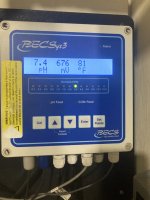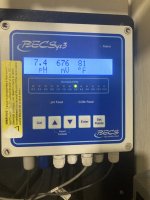How are you getting a reading of 2 for CYA?
What are you keeping the ORP level at?
Does the BECSys3 system chlorine reading match your drop test kit results?
View attachment 559348
The controller has an optional free chlorine sensor, which can be selected for sanitizer feed control rather than ORP.
If using ORP, a derived chlorine ppm display is also available, which provides an approximation of the residual chlorine level on a 0.2 to 16 ppm scale.
The BECSys3 can also be configured without a PPM scale, displaying only the pH and the ORP readings only.
Do you have the optional free chlorine sensor?
Every controller comes complete with either pH and ORP sensors or pH, free chlorine and temperature sensors, flow switch, machined flow cell, and factory-trained start-up and support provided by local distribution in most regions.
Hotel indoor pool CC not coming down
- Thread starter JordanB
- Start date
You are using an out of date browser. It may not display this or other websites correctly.
You should upgrade or use an alternative browser.
You should upgrade or use an alternative browser.
It looks like a "Derived" ppm for the chlorine, which is estimated from the ORP.
It is not a true chlorine test like you would get from the optional free chlorine sensor.
What is the ORP set to?
Does the system reach the set point?
It is not a true chlorine test like you would get from the optional free chlorine sensor.
What is the ORP set to?
Does the system reach the set point?
Pool smells fine. No harsh smells, that’s why I’m puzzled. Maybe CC is false? But regardless of if I adjust my FC up or down, the TC rises or falls according.If accurate, those are some pretty high CCs.
Question: How does the water smell? When you go into the pool room, does your nose instantly say YUK? If there is an unpleasant scent, then the CC are definitely very high. It is the CC's that a lot of non-savvy people call "chlorine" smell that they object to. A sanitary and clean pool will smell fresh and pleasant with perhaps a very slight scent of fresh chlorine.
It's up to you to go this route or not, but I would highly recommend getting this FAS DPD test kit. It will provide accurate measurements up to 50ppm. You can really get a good grip on your chlorine levels using this kit.

FAS/DPD Chlorine Test Kit
tftestkits.net
I suggest also doing an Overnight Chlorine Loss Test. Since the pool is indoor, maybe you can do this during the day, but the pool must be closed, no swimmers. If there are large windows that the sun shines directly through, then cover them. Do not do anything, at all, to the pool during this test. If there is a Skylight in the pool room ceiling, then you'll have to do this test at night.
Take a FC test (we do this at night to eliminate UV from the sun burning off chlorine).
10-12 hours later (or for us early the next morning before sunrise), test the FC again.
There should be No More Than 0.5ppm loss of FC.
If the FC loss exceeds 0.5, then there are organics in the water that is consuming the FC, and causing the high CC test results.
Maybe this calculator may be of some help to you also. At the bottom of the calculator is a category named "Effects Of Adding Chemicals". At the top of the calculator, you will need to enter the volume of your pool for the calculator to be accurate. You can play around with this so as to have an accurate expectation of results of a test before you add any chemicals.
PoolMath
Discover the calculator behind the perfect pool, PoolMath. Dealing with pools has allowed TFP to become the original authors of the best calculator on the net.www.troublefreepool.com
Yes reaches and maintains just fine. Like I said I have no issues maintaining my FC, it actually seems to stay fairly steady and doesn’t call for much chlorine to be addedIt looks like a "Derived" ppm for the chlorine, which is estimated from the ORP.
It is not a true chlorine test like you would get from the optional free chlorine sensor.
What is the ORP set to?
Does the system reach the set point?
I work with another guy who has been here 29 years, he knows every switch, screw and bolt in this entire hotel. He’s just as lost about this as I am! He’s an older fellow and not tech savvy which is why I’m postingYou sure some system has not broken? Like a UV or Ozone system you are not aware of?
29 year experienced guy works in my departmentMaybe that is what they told you, but it is highly unlikely.
I have a photocell DPD tester, as stated, a Palintest Pooltest 6. I can test for FC, TC, alk, calcium hardness, and CYA. I test the water every 2 hoursTry an FAS-DPD test.
Do you use MPS?
If you increase the FC the TC should rise with it.Pool smells fine. No harsh smells, that’s why I’m puzzled. Maybe CC is false? But regardless of if I adjust my FC up or down, the TC rises or falls according.
If you decrease it the TC should lower with it.
If you have CC's they should stay the same (within a reasonable period of time) no matter what you do with the FC
It's very odd though, that with 2 ppm of CYA, and rather high FC, that your CC are so high. That doesn't make any sense for a pool that isn't full of algae.
I just noticed you are in Canada, I'm not sure if you can get an FAS DPD from TFTest Kits
It looks like you might be able to get it on Amazon though.
Last edited:
I still recommend that you get an FAS-DPD test kit to see what that shows.
Do you ever use any type of nonchlorine shock?
Can you list all chemicals that you use?
Do you ever use any type of nonchlorine shock?
Can you list all chemicals that you use?
Pool is 21000 gallons approximately or 79000 litres. We haven’t been using any non-chlorine shock like MPS but might have to. It’s a hotel pool so user load varies. Some days it’s maybe a dozen people over 15 hours, other days it could be 80 people. Pool is open from 7am until 11pmWhat is the pool size?
How many people use the pool?
- May 27, 2021
- 1,395
- Pool Size
- 17000
- Surface
- Fiberglass
- Chlorine
- Salt Water Generator
- SWG Type
- Pentair Intellichlor IC-40
As James already stated the Becs 3 display is not reliable as a testing means because it’s converting ORP to estimated FC. Test your water. To test higher levels of FC with your Palintest you will have to test using the dilution method with distilled water as outlined in the manual or found on Palintest website. Even with that method there’s an increased margin of error in the results.
When was the last time your test kit was calibrated? Do you have check standards to verify its accuracy? I love Palintests but get one of the FAS DPD kits recommended here as a reliable backup if you’re in doubt of the test results or to accurately read higher chlorine levels…say when you superchlorinate.
Based on the drop you saw in CC, I suspect you didn’t reach BC. BC is not a moment in time but a process. There are points until reaching BC where CC will drop but until your reach BC you won’t destroy them totally and subsequently build a residual of FC. Furthermore I would estimate you need to run you daily FC higher to prevent CC buildup. I would hypothesize your‘re running on the low ragged edge of FC for your bather load and are not destroying organic wastes fast enough. If you find yourself on the train of needing to superchlorinate often because of CC buildup then you’re not sanitizing enough every day to destroy what’s being put in the water via bather load. Here’s a good article that may help you understand the concept Understanding Breakpoint Chlorination
Of course with an indoor pool - outdoor air exchanges and ventilation have an effect on eliminating CC and are critical. If you aren’t exchanging air, chloramines can’t go anywhere when they offgas during the oxidation process and they will fall back into the water. Do you truly know your makeup air is adequate for your facility?
Your options are to try and reach BC again via superchlorination or drain and refill to start fresh. Theoretically you could use MPS to oxidize them and allow your FC an opportunity to sanitize more efficiently but if you can’t exchange enough air fast enough MPS may not be of much help either. MPS can also have other side effects - interference in testing that reads as CC which then requires additional steps in your testing to eliminate the interference.
When was the last time your test kit was calibrated? Do you have check standards to verify its accuracy? I love Palintests but get one of the FAS DPD kits recommended here as a reliable backup if you’re in doubt of the test results or to accurately read higher chlorine levels…say when you superchlorinate.
Based on the drop you saw in CC, I suspect you didn’t reach BC. BC is not a moment in time but a process. There are points until reaching BC where CC will drop but until your reach BC you won’t destroy them totally and subsequently build a residual of FC. Furthermore I would estimate you need to run you daily FC higher to prevent CC buildup. I would hypothesize your‘re running on the low ragged edge of FC for your bather load and are not destroying organic wastes fast enough. If you find yourself on the train of needing to superchlorinate often because of CC buildup then you’re not sanitizing enough every day to destroy what’s being put in the water via bather load. Here’s a good article that may help you understand the concept Understanding Breakpoint Chlorination
Of course with an indoor pool - outdoor air exchanges and ventilation have an effect on eliminating CC and are critical. If you aren’t exchanging air, chloramines can’t go anywhere when they offgas during the oxidation process and they will fall back into the water. Do you truly know your makeup air is adequate for your facility?
Your options are to try and reach BC again via superchlorination or drain and refill to start fresh. Theoretically you could use MPS to oxidize them and allow your FC an opportunity to sanitize more efficiently but if you can’t exchange enough air fast enough MPS may not be of much help either. MPS can also have other side effects - interference in testing that reads as CC which then requires additional steps in your testing to eliminate the interference.
Last edited:
Thread Status
Hello , This thread has been inactive for over 60 days. New postings here are unlikely to be seen or responded to by other members. For better visibility, consider Starting A New Thread.





